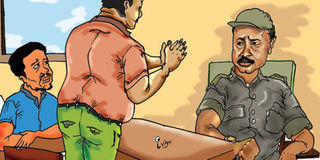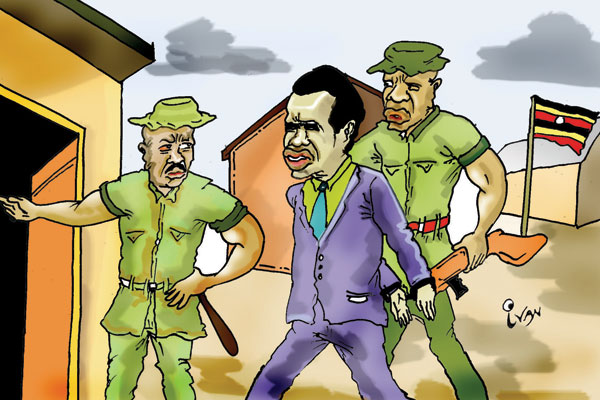Museveni sends army to quell Busia rebellion

Meeting. An Illustration of President Museveni (right) meeting Resistance Council members from Bukedi sub-region at the Rubongi Army Barracks in Tororo. ILLUSTRATIONS BY IVAN SENYONJO
What you need to know:
Part II. Thanks to intense lobbying by Mr Chango Macho, a founding member of the Uganda Patriotic Movement (UPM), who had risen to become a member of President Museveni’s Cabinet and later member of the National Resistance Council, Mr Museveni agreed to meet the affected RCs in Bukedi sub-region.
Much as the rebels had split Busia into three theatres of operation, each assigned to a particular group, the forces within particular theatres were further split into small bands.
It was not known whether this was intended to avoid detection and attacks from the NRA or to ensure quicker movement in their respective theatres.
Most of the members of the ad hoc Resistance councils, NRM cadres and known supporters of the new leadership in Kampala who were the rebels main targets were by the close of January 1987 living in a state of fear.
The rebels had within the first three weeks of their operations killed more than 20 people, including Alex Mayende Avon, Zakayo Barasa, Esibaberi Oundo and Odwori Kurumbano, the RCIII secretary for defence in Bulumbi Sub-county, one Mutembete, and the RCIII secretary for information in the same sub-county, one Wadidwa.
In fear
One of those who were living in fear was Semeo Makokha. Makokha, a businessman at the time, had warmed up to the arrival of the NRM/A and was quick to join its mobilisation activities.
During the three days of the elections dating back to May and June 1986, he was elected RCI chairman of his village, RCII general secretary of his parish and subsequently RCIII chairman of the sub-county.
The sub-county was, however, home to so many former soldiers of the Uganda National Liberation Army (UNLA) and former operatives of the Special Forces.
It constituted what was known as Busia South, where the most notorious of the rebel commanders, 2nd Lt Franco Mangeni, alias Nabutono (the small bodied one), Charles Ojambo, alias Korokoto, David Wabwire, alias Masingo (cow dung), Vincent Oguttu and Thomas Mangeni operated.
“So intense was the situation that many of us had fled our homes. Others were contemplating resigning from the committees, but to who were we going to hand our resignation letter?” Mr Makokha says as he narrates his ordeal.
Thanks to intense lobbying by Mr Chango Macho, a founding member of the Uganda Patriotic Movement (UPM), who had risen to become a member of President Museveni’s Cabinet and later member of the National Resistance Council (NRC), Mr Museveni agreed to meet the affected RCs in Bukedi sub-region. The meeting was scheduled to take place on January 27, 1987.

An Illustration of the FOBA rebels torturing a resident of Masaba Sub-county before killing him.
Mr Makokha had been scheduled to lead the team from Masafu, but one of his relatives who also happened to have been an RC, had been killed by the rebels on January 13 and burial was to take place on the same day that they were scheduled to meet the President. He delegated his close friend and member of the sub-county’s executive committee, Mr Alex Mayende, to lead the team.
About a week before the meeting, suspected rebels had invaded Mayende’s home, doused the house and furniture with petrol before setting it alight. Nobody died, but the damage was extensive.
“All the things that were in the house, sofa sets, dining tables, and all other things were burnt out and razed to the ground. The animals, including seven cows, two bulls and two sheep, were hacked into pieces. They just hacked and killed them. They never took anything,” he recounts.
Mr Mayende was forced to flee to Masafu Trading Centre where he also had a house. He was forced to reinforce the doors of the house and sought armed guards. His security was later backed up by NRA soldiers.
Initially, the meeting had been scheduled to take place at Rock Hotel in Tororo District, was shifted to the Officers’ Mess in Rubongi Army Barracks in Tororo.
READ:
“I would like to see the chairman of Masafu,” President Museveni is quoted to have said.
“I was a bit afraid. Why was he particularly asking for the chairman of Masafu? But if there had been a problem, I would have simply said that I was representing Makokha,” he recalls.
The mess was teeming with soldiers, RCs and some of the LDUs who were working in Bukedi region at the time. Mayende weaved his way through to the front where Mr Museveni was seated along with some of his Generals.
“What can I do for you?” Museveni asked.
“My son, there is nothing I want from you. I want you to save your people. FOBA is finishing them off,” Mayende shot back.

An Illustration of the NRA soldiers engaging the rebels in Busia. President Museveni sent two companies, each with about 100 men, to deal with the rebels.
Mr Museveni then promised that soldiers would arrive in Masafu the following day.
The following day, sounds of heavy engines were heard reverberating around the sub-county as hundreds of soldiers were ferried into the area. The soldiers were cheerful.
“Kazi mingi tuli fanya na wanainchi wenyewe…
Tuta piga haduyi natutamuwondowa Masafu” (we have previously accomplished so many missions with the cooperation of the citizens… We shall beat the enemy and flush him out of Masafu” they sang from atop their trucks.
They were two companies, each with about 100 men. The soldiers initially camped at Busiho Primary School where they stayed for quite some time before they were transferred to Masafu where they were assigned one of the police houses and they set up a detachment within the grounds of the sub-county headquarters. The group was later split into two with another setting up a detach in Bumungi.
Their arrival did not stop the rebels. About a week after their arrival, the rebels shot and killed cadre Tanga Kadu.
Even though government had earlier anticipated a rebel incursion into Busoga and moved to recruit and train a Local Defence Force unit, things did not go as planned.
The men were undergoing training in Serere when Alice Lakwena’s Holy Spirit Movement made its march to the south. One of the places that were overrun by the rebels was the training camp in Serere. Many of the trainees were killed. Those who survived fled further south. Even when they regrouped, they were still not equal to the task of beating off the rebels.
At the same time, it would appear that the rebels’ decision to split their forces into smaller and highly mobile bands made it very difficult for the army to trace them.
While their targets were known, the rebels did not seem to have any definite method of either torturing or killing or doing both, torture and kill whoever they targeted. In some cases they would torture and let go, but most of the times they would torture and kill.
In most cases, the killing would be followed by looting the victim’s property, hacking the animals and torching the houses. Where the houses would be burnt, they would leave the bodies of their victims to burn to a cinder.
The methods of killing seemed to depend on the mood of the commander. For example on October 18, 1987, when Masingo and his men invaded the home of Vincent Wafula Makata in Sibinduha village, Mbehenyi Parish in Masaba Sub-county, they first beat him up before ordering the carpenter and businessman who used to operate a shop in Butakyo Trading Centre to kneel down and killed him by hitting his head.
“They hit him with a hammer on the head. It was a very vicious blow. He could not have stood any chance (of survival),” his son John Bwire, a bursar at Dabani Girls’ School, narrates.
The rebels then ordered the family out, leaving the body of the man who was the RCII chairman of Mbehenyi Parish behind. They then set the house ablaze.
“The body was in there. It was burnt beyond recognition. Actually it was just the bones that were left,” Bwire recounts.
On November 11, 1987, when the same band of rebels returned to Bukyato trading centre to attack an LDU man, George Namukemo Wabwire, they ordered him to lie face down before shooting him dead. The same night they killed Vincent Wabwire of Esaga village and Fero Wafula in Masaba Sub-county.
By the time the guns fell silent, the rebellion had claimed a total of 80 lives.
Next week read about four men’s tales of escaping death at the hands of FOBA





